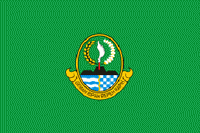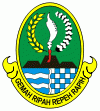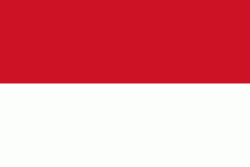West Java (Jawa Barat)
 |
 |
West Java was one of the first eight provinces of Indonesia formed following the country's independence proclamation and was later legally re-established on 14 July 1950. In 1966, the city of Jakarta was split off from West Java as a 'special capital region' (Daerah Khusus Ibukota), with a status equivalent to that of a province, while in 2000 the western parts of the province were in turn split away to form a separate Banten province.
Even following these split-offs, West Java is the most populous province of Indonesia with a population of 48,274,160 as of the 2020 Census, which grew to 48,782,402 at mid 2021 according to the official estimates. The province's largest cities, Bekasi (a satellite city within the Jakarta metropolitan area) and Bandung, are the third and fourth most populous cities in Indonesia respectively. Bandung is also one of the most densely populated cities proper in the world.
The oldest human inhabitant archaeological findings in the region were unearthed in Anyer (the western coast of Java) with evidence of bronze and iron metallurgical culture dating to the first millennium AD. The prehistoric Buni culture (near present-day Bekasi) clay pottery were later developed with evidence found in Anyer to Cirebon. Artefacts (dated from 400 BC — AD 100), such as food and drink containers, were found mostly as burial gifts. There is also archaeological evidence in Batujaya Archaeological Site dating from the 2nd century and, according to Dr Tony Djubiantono, the head of Bandung Archaeology Agency, Jiwa Temple in Batujaya, Karawang, West Java was also built around this time.
One of the earliest known recorded histories in Indonesia is from the former Tarumanagara kingdom, where seven fourth-century stones are inscribed in Wengi letters (used in the Pallava period) and in Sanskrit describing the kings of the kingdom Tarumanagara. Records of Tarumanegara's administration lasted until the sixth century, which coincides with the attack of Srivijaya, as stated in the Kota Kapur inscription (AD 686).
The Sunda Kingdom subsequently became the ruling power of the region, as recorded on the Kebon Kopi II inscription (AD 932).
An Ulama, Sunan Gunung Jati, settled in Cirebon, intending to spread the word of Islam in the pagan town. Meanwhile, the Sultanate of Demak in central Java grew to an immediate threat against the Sunda kingdom. To defend against the threat, Prabu Surawisesa Jayaperkosa signed a treaty (known as the Luso-Sundanese Treaty) with the Portuguese in 1512. In return, the Portuguese were granted an accession to build fortresses and warehouses in the area, as well as forming trading agreements with the kingdom. This first international treaty of Sunda Kingdom with the Europeans was commemorated by the placement of the Padrao stone monument at the bank of the Ciliwung River in 1522.
Although the treaty with the Portuguese had been established, it could not come to realisation. Sunda Kalapa harbour fell under the alliance of the Sultanates of Demak and Cirebon (former vassal state of Sunda kingdom) in 1524 after their troops under Paletehan alias Fadillah Khan had conquered the city. In 1524–1525, their troops under Sunan Gunung Jati also seized the port of Banten and established the Sultanate of Banten which was affiliating with Demak. The war between the Sunda kingdom with Demak and Cirebon sultanates continued for five years until a peace treaty was made in 1531 between King Surawisesa and Sunan Gunung Jati. From 1567 to 1579, under the last king Raja Mulya, alias Prabu Surya Kencana, the Sunda kingdom declined, essentially under pressure from Sultanate of Banten. After 1576, the kingdom could not maintain its capital at Pakuan Pajajaran (present-day Bogor), and gradually the Sultanate of Banten took over the former Sunda kingdom's region. The Mataram Sultanate from central Java also seized the Priangan region, the southeastern part of the kingdom.
In the 16th century, the Dutch and the British trading companies established their trading ships in western Java after the fall of Sultanate of Banten. For the next three hundred years, western Java fell under the Dutch East Indies' administration. West Java was officially declared as a province of Indonesia in 1950, referring to a statement from Staatblad number 378. On 17 October 2000, as part of nationwide political decentralisation, Banten was separated from West Java and made into a new province. There have been recent proposals to rename the province Pasundan ("Land of the Sundanese") after the historical name for West Java.
Map - West Java (Jawa Barat)
Map
Country - Indonesia
 |
 |
| Flag of Indonesia | |
As the world's third largest democracy, Indonesia is a presidential republic with an elected legislature. It has 38 provinces, of which nine have special status. The country's capital, Jakarta, is the world's second-most populous urban area. Indonesia shares land borders with Papua New Guinea, East Timor, and the eastern part of Malaysia, as well as maritime borders with Singapore, Vietnam, Thailand, the Philippines, Australia, Palau, and India. Despite its large population and densely populated regions, Indonesia has vast areas of wilderness that support one of the world's highest level of biodiversity.
Currency / Language
| ISO | Currency | Symbol | Significant figures |
|---|---|---|---|
| IDR | Indonesian rupiah | Rp | 2 |
| ISO | Language |
|---|---|
| NL | Dutch language |
| EN | English language |
| ID | Indonesian language |
| JV | Javanese language |































